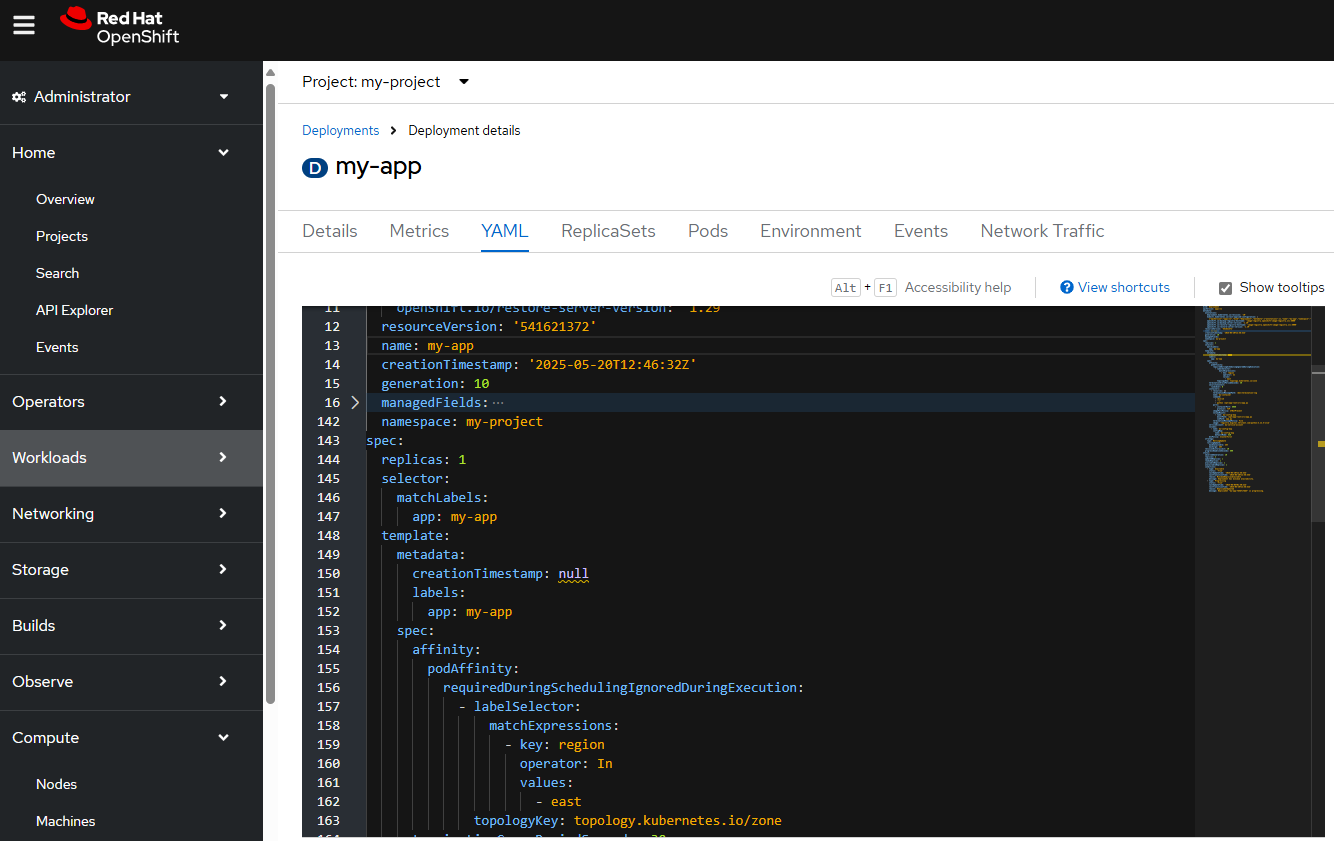
If you are not familiar with the oc command, refer to OpenShift - Getting Started with the oc command.
There are a few different ways to run a pod on a specific node.
- Using nodeSelector
- Nodes are labeled with a key=value (e.g. region=east)
- If namespace node-selector is an exact match of a nodes key=value label, then the pod can be scheduled run on the node
- If a pods "nodeSelector" is an exact match of a nodes key=value label, then the pod can be scheduled run on the nodenode
- Using nodeAffinity
- Nodes are labeled with a key=value (e.g. region=east)
- If a pods "nodeAffinity" regular expression matches a nodes key=value label, the pod can be scheduled to run on the node
- Using podAffinity (this article)
- Pods are labeled with a key=value (e.g. region=east)
- If a pods "podAffinity" regular expression matches another pods key=value label, the pod can be scheduled to run on the same node that the other pods is running on
- Using Taint and Toleration
- Nodes are labeled with a key=value:taint (e.g. region=east:NoSchedule)
- If a pods tolerations uses "Exists" and the pods tolerations key matches the nodes toleration key, the pod is allowed to run on the node
- If a pods tolerations uses "Equal" and the pods tolerations key and value is an exact match of the nodes tolerations key and value, the pod is allowed to run on the node
The oc new-app command is used to deploy an application. There are various ways to deploy an app.
- From GitHub (https://github.com)
- From Docker Hub (https://hub.docker.com)
- From an image
- From a build
- From a JSON or YAML file (templates)
The scheduler is responsible for determining which worker node a resource should get created on. For example, when deploying a new application to OpenShift, the scheduler determines which worker node the pod should be created on, typically the worker node with the most available memory and CPU. Check out my article on the default scheduler.
With podAffinity, you will first label a pod with any key value pair that you would like. Let's say my-pod-c4v5h is labled region=east.
~]$ oc label pod my-pod-c4v5h region=east
pod/my-pod-c4v5h labeled
And get oc get pods --output wide command can be used to see that the node the pod in running on (worker-hsjrp in this example).
~]# oc get pods --output wide
NAME READY STATUS RESTARTS AGE IP NODE NOMINATED MODE
my-pod-c4v5h 1/1 Running 0 8d 10.142.118.51 worker-hsjrp <none>
Now let's say you have another pod (my-pod-zm7d6) that you want to ensure is run on the same node (worker-hsjrp). You could update the pods deployment YAML to have the following podAffinity to have the pod run on the same node as the pod that has label region=east.
With podAffinity, the scheduling of the pod on a node can either be preferred or required. Execution basically means "running pods" thus IgnoredDuringExecution means that the podAffinity will have no impact on currently running pods. On the other hand, with Taint and Toleration, NoExecute can be used to terminate running pods.
- preferredDuringSchedulingIgnoredDuringExecution
- requiredDuringSchedulingIgnoredDuringExecution
The following operators can be used with matchExpression. In this example, my-pod-zm7d6 will be required to run on the same node as the pod with label region=east is running on.
- In (worker node label contains one of the listed key:value pairs)
- NotIn (worker node label does not contain one of the listed key:value pairs)
- Exists (worker node label is an exact made of the key, not the value)
- DoesNotExist (worker node label is not an exact made of the key)
- Lt (worker node label is less than)
- Gt (worker node label is greater than)
apiVersion: apps/v1
kind: Deployment
metadata:
name: my-deployment
spec:
template:
spec:
affinity:
podAffinity:
requiredDuringSchedulingIgnoredDuringExecution:
- labelSelector:
matchExpressions:
- key: region
operator: In
values:
- east
topologyKey: topology.kubernetes.io/zone
Or in the OpenShift console at Workloads > Deployment > your deployment > YAML.

Did you find this article helpful?
If so, consider buying me a coffee over at 